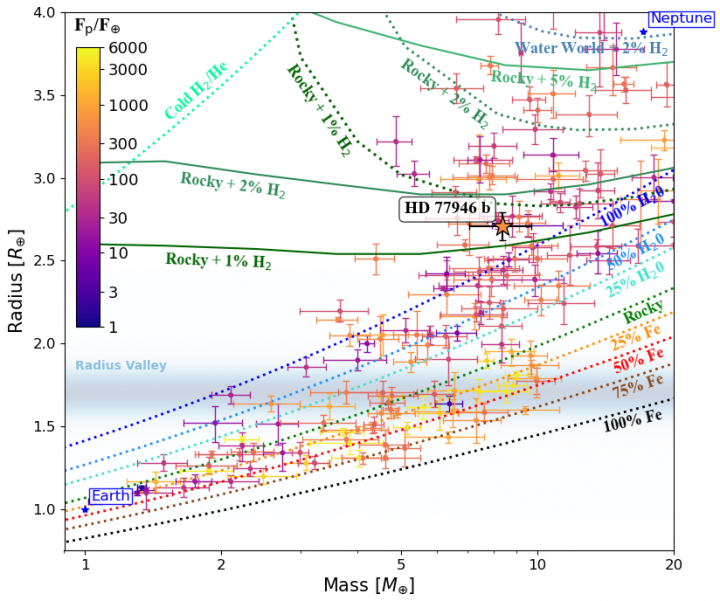Confronting compositional confusion through characterising a sub-Neptune exoplanet
Precisely characterising exoplanet masses and radii can help to resolve a compositional confusion for small exoplanets and improve our understanding of the origin of these exoplanets and their evolution.
Using both the radial velocity and transit methods, it is possible to estimate both the mass and radius of an exoplanet. This can then tell us about the planet's internal composition and the possible presence of an atmosphere. However, there is a region of mass-radius space where there is still compositional confusion. Exoplanets with masses of around 10 Earth masses and radii between 2.5 and 3 Earth radii could be sub-Neptunes with rocky cores and low-mass hydrogen/helium atmospheres, or they could be water-worlds, with water making up a significant fraction of their mass. Therefore, precisely characterising exoplanets in this region of mass-radius space is crucial for not only understanding their composition, but also for understanding the origin of these exoplanets.

In this paper (Palethorpe et al. 2024) we used high-precision radial velocity measurements from HARPS-N, located on the Telescopio Nazionale Galileo on La Palma, together with transit observations from NASA's TESS satellite and ESA's CHEOPS satellite to characterise a sub-Neptune around the star HD 77946. We find that HD 77946 b has a mass of 8.38 ± 1.32 Earth masses and a radius of 2.71 ± 0.09 Earth radii, placing it into the region of mass radius space where there is confusion about its possible composition.
Our analysis of the composition of HD 77946 b suggests that it has a rocky core surrounded by a hydrogen/helium atmosphere that is about 1% of its mass, but makes up about 1/4 of its radius. This is consistent with its position on an exoplanet mass-radius diagram, as shown by the figure on the right. The curves on the figure are for different compositions, and it lies in a region where it cost host a low-mass hydrogen atmosphere.
However, HD 77946 b is also very hot, which means that we can't rule out that it is a water world with water, in a super-critical state, making up 20-50% of its mass. One way to resolve this degeneracy would be to use transmission spectroscopy to determine the atmospheric composition. Although not easy, HD 77946 b is one of the best targets around a hot star, with a precise mass and radius, for such observations.
Being able to confirm, or rule out, the existence of water worlds for stars like the Sun could have strong implications for our understanding of exoplanet demographics and the origin of our own Solar System.
References:
Palethorpe, L., et al., 2024, Confronting compositional confusion through the characterisation of the sub-Neptune orbiting HD 77946, Monthly Notices of the Royal Astronomical Society, in press.

